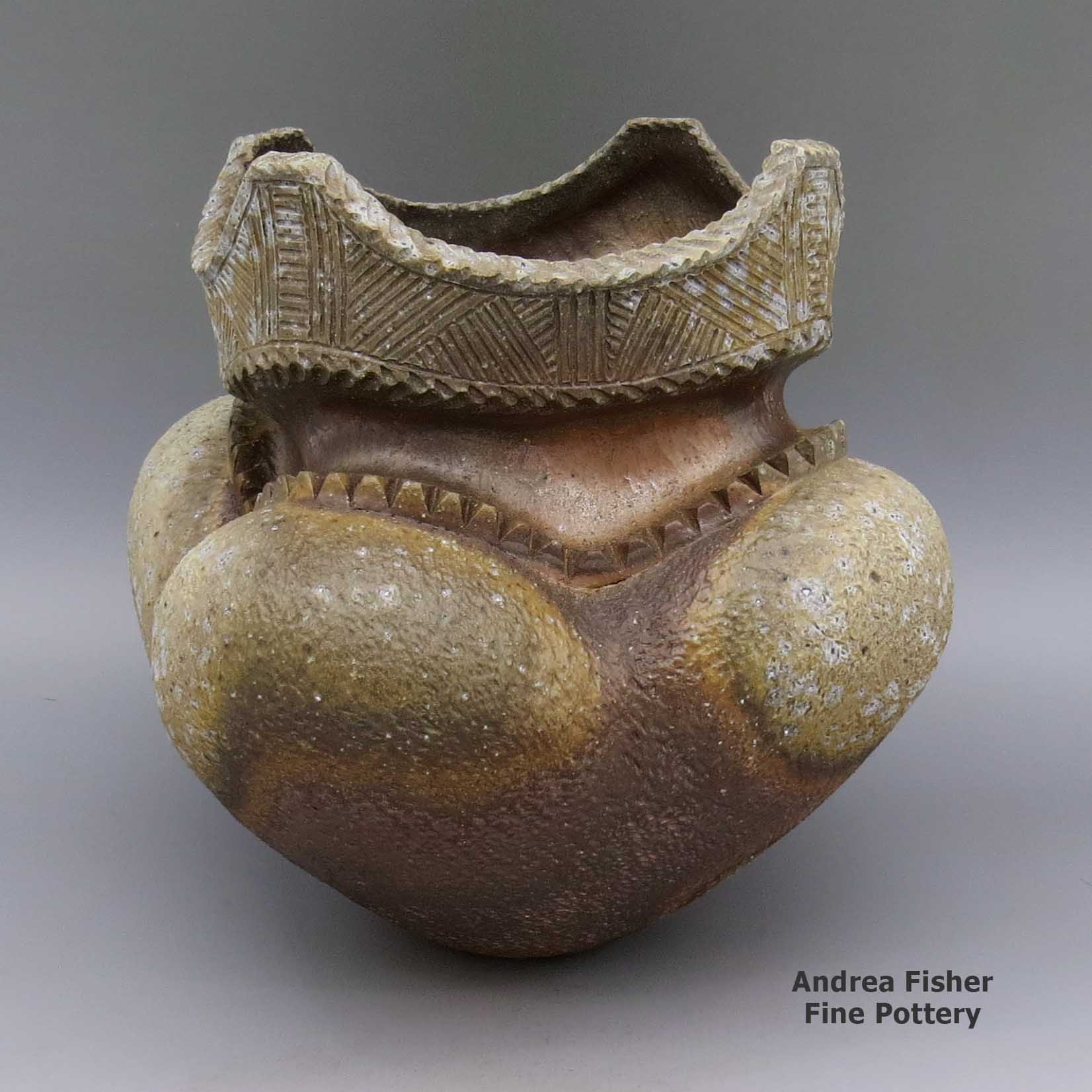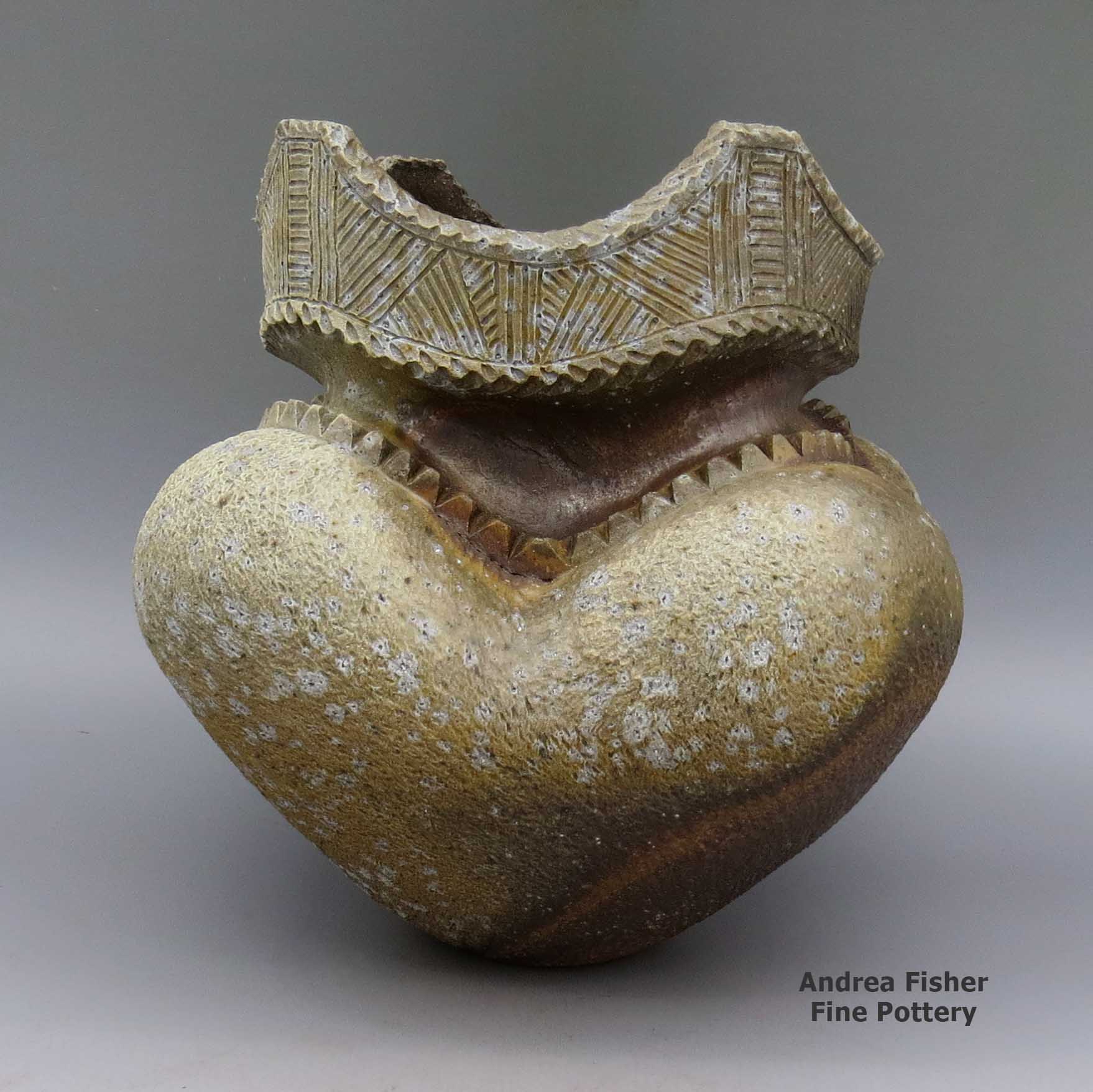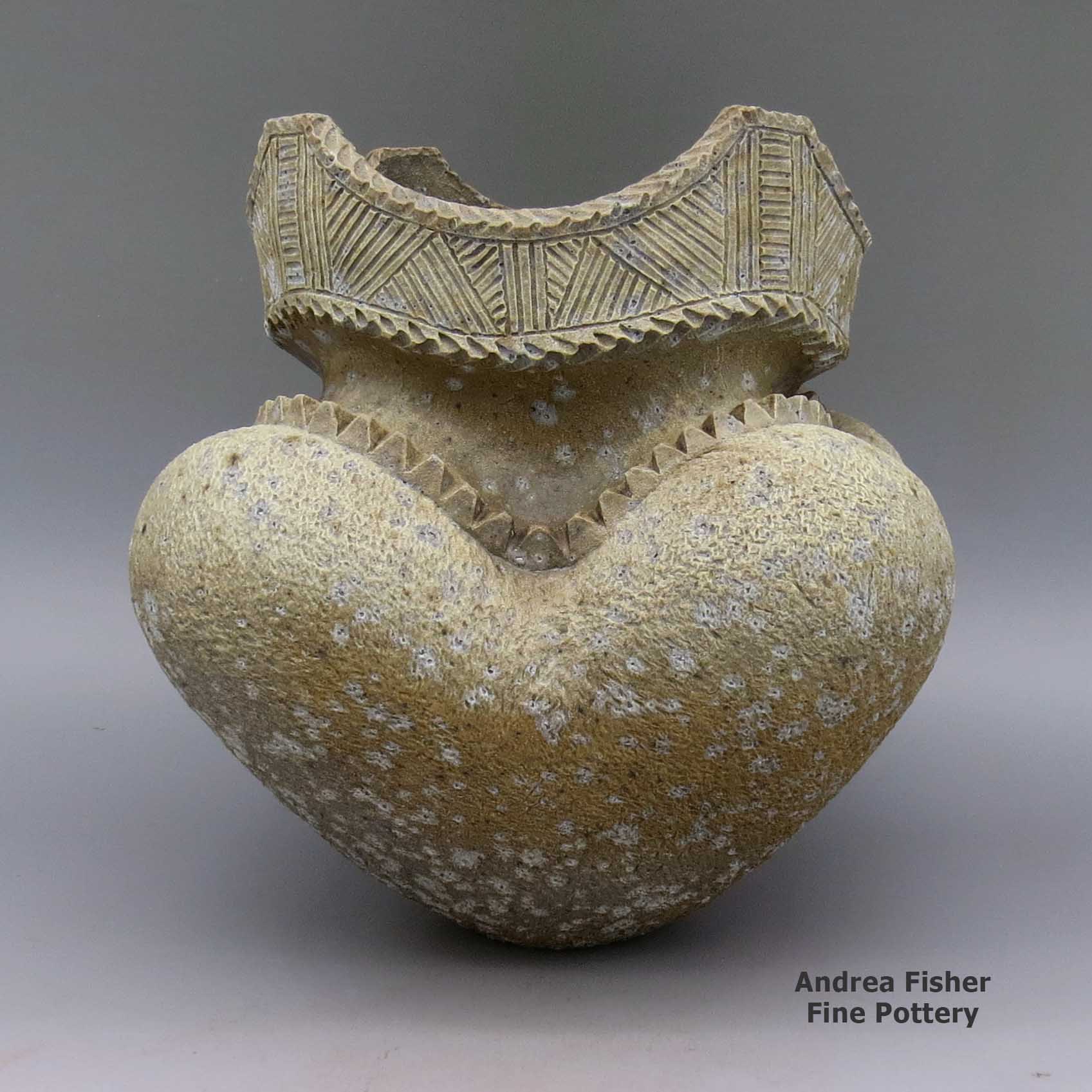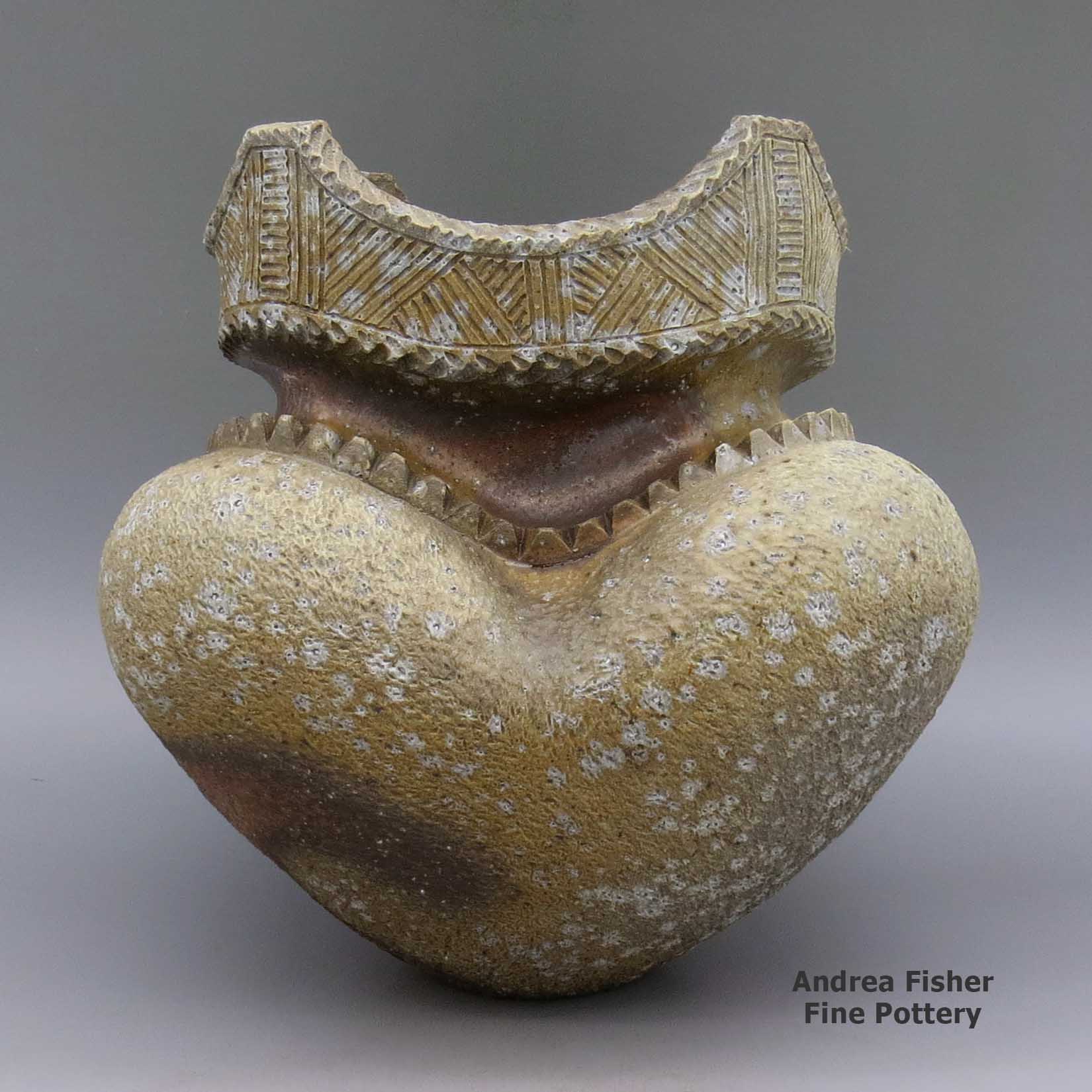| Dimensions | 10 × 9.5 × 10.25 in |
|---|---|
| Condition of Piece | Excellent |
| Date Born | 2022 |
Jamie Zane Smith, zzmm2j170, Polychrome jar with distinctive shape
$4,900.00
A polychrome jar with a sgraffito-and-carved crown and opening, a distinctive shape and texture, and fire clouds
In stock
Brand
Smith, Jamie Zane
 Jamie Zane Smith tells us he has a strong personal commitment to building Wyandot pottery. He's working to retain an integral sense of form inspired by sensibilities from a time when people lived in the full awareness that they were not separate from the Earth.
Jamie Zane Smith tells us he has a strong personal commitment to building Wyandot pottery. He's working to retain an integral sense of form inspired by sensibilities from a time when people lived in the full awareness that they were not separate from the Earth.Jamie uses traditional resources to create pottery that speaks to the modern world. For him, his creating of pottery is a participation in the flow of Nature, from a perspective where humans and Nature are not dueling entities but rather a single continuous flowing of prayer in a language of glory to the Creator.
Jamie has learned much through watching his uncle, Richard Zane Smith, creating his own form of Wyandot pottery. Jamie spent a year in Wyandotte, Oklahoma, studying with his uncle. He learned that the making of pottery is a spiritually honest form of sensibility. There's also something about getting his hands into and working with clay that speaks to his heart. From Richard he also learned the ancient ways of how to harvest his clay and make his paints, anywhere he might be.
Jamie says he grew up in the city and has traveled the world since finishing his formal education. The time spent with his uncle convinced him that the rural way of life is the life he wants to live with his wife and their two daughters.
These days he and his family live "lightly and simply" in an old two-room schoolhouse in the Ozark Mountains of Missouri. In a small valley at the point where two creeks meet, the schoolhouse hasn't changed much since the days when his wife's grandparents attended school there. Jamie says the peace and the beauty of the ever-changing wooded landscape are a constant inspiration for him. He marries that inspiration often with some of the hallmarks of ancient Wendat pottery: heavy collars, crowns, multiple shoulders, scalloped and notched rims, and rounded bases.
A Short History of the Wyandot People

Before the arrival of Columbus, the ancestors of today's Wyandot(te) lived mostly in the countryside stretching north from the north shore of Lake Ontario to the north and east shores of Georgian Bay (on Lake Huron to the north). Members of the tribe were scattered as far south as the Kanawha River in central West Virginia but as Europeans flooded in from the east in the 1600s and 1700s, they were pushed out, forced to move north and rejoin the rest of their tribe.
In their Ontario homelands, there were basically five nations making up the Huron Confederacy. Most of today's survivors we now know as Wyandot but originally the tribe was known as Huron, based on their occupation of lands to the north, east and south of Lake Huron.
Around 1600 the tribe was comprised of two primary groups: the Huron Confederacy (of the 5 nations) and their neighbors to the south and southwest, the Tionontate (also known as the Tobacco people, after their principal commodity crop). Like the Huron, the Tionontate were longhouse dwellers and spoke a very similar dialect. The Anishinabe, to the north and east, were also longhouse dwellers and spoke a similar dialect.
When news of the French arrival in North America reached the Huron, some of them decided to go and meet the newcomers. Samuel de Champlain was exploring the upper reaches of the St. Lawrence River at that time. The two groups came together in 1609 and a political and trade alliance was forged. Within 20 years of that fateful meeting with Champlain, the tribe was reduced from about 30,000 members to maybe 12,000 due to diseases brought by the French that the indigenous people had no immunity to. At the same time, the Dutch and English presence was having similar impacts among the tribes south of the St. Lawrence and the Great Lakes. That effect mushroomed after the British took over the Dutch colonies in the mid-Atlantic area.
The drop in population was so catastrophic to the Huron that whole villages, families and clans disappeared and agricultural lands were abandoned. Jesuit missionaries were spreading everywhere and they further fractured the tribe into "redeemed" and "unredeemed" heathens. As the Europeans encouraged the fur trade in the New World and beavers were pushed almost to the brink of extinction, conflict among the tribes increased significantly. As the most advanced trading nation in the area of French claim, the French invested more in their alliance with the Huron while the English allied themselves with the Hurons' mortal enemies: the Seneca and the Haudensaunee (Hutinǫhšǫdih) Iroquois to the west and south.
A difference between the Dutch/English and French invasions: the Dutch and English would trade firearms with anyone for beaver pelts while the French required conversion to Christianity before allowing any trade in firearms. When push came to shove (as it did with the French & Indian War), France's allies were outgunned and outnumbered by Britain's allies. In the aftermath of that conflict, France's New World allies were made to suffer further.
The Huron enjoyed good trade and amicable relations with their Anishinabe neighbors (the Anishinabe even shared longhouses with the Huron and some families straddled tribal lines). Neither tribe wanted any disruption of that. However, the disparity in access to firearms and the growing scarcity of beaver led the Haudensaunee Iroquois to attack two Huron villages in present-day Simcoe County, Ontario, killing about 300 people on March 16, 1649. By May 1, 1649, the Huron had burned 15 more of their own villages to prevent their stores from being taken and used by their enemies. Many of those people fled into surrounding areas where they were taken in as refugees by other tribes. About 10,000 Huron fled to Christian Island in Georgian Bay but most of those starved to death over the following winter. Many of the survivors of that winter made their way downstream along the St. Lawrence and settled at Wendake, near Quebec City, where their descendants remain to this day (these are today's Wendat people, a Canadian-government recognized First Nation).
As the massive Iroquois and Seneca war party made its way around in Huron territory in 1649, they attacked other Huron and Tobacco people villages. That resulted in the Bear Clan of the Huron merging with the Tionontate as refugees from both flowed across Lake Huron and Lake Michigan to the area of Green Bay. A couple seasons later most of those moved north and settled in the area of Michilimackinac. Others scattered to the west and south, passing into southeastern Michigan and across Ohio into the Ohio River Valley in the early 1700s. At that point the Huron and Tionontate in the west were essentially one tribe: Wandat. At the time, Wandat meant "people of the village" or "people of the island," but as the 1800s rolled on that definition was reduced to "villager" and the word itself morphed to Wyandot. That's when the name Wyandot came into general usage.
When the American Revolution came along, the Wyandot allied themselves with the British against the Americans and in one of the last engagements of the Revolutionary War (the Battle of Blue Licks, fought 10 months after the surrender of Cornwallis at Yorktown), they surrounded and defeated the Kentucky militia led by Daniel Boone. During the Northwest Indian War (1785-1795) they fought alongside the British and were signatories to the Treaty of Grenville in 1795 (other signatories to that treaty: Meriwether Lewis and William Clark of the 1804-1806 Lewis & Clark Expedition and William Henry Harrison, later the 9th President of the United States). However, in 1807, along with the Potawatomi, Odawa and Ojibwe peoples, they were led into signing the Treaty of Detroit. Instead of protecting those tribes from continuing encroachment on their lands by Euro-American immigrants and settlers, that treaty ceded most of their holdings in southern Michigan and northwestern Ohio to the government of the United States for a minimal cash payment and annuity. They were allowed to keep small pockets of land in the area but this treaty was the beginning of the forced migrations of the US government policy of Indian removal.
In the 1840s most of the surviving Wyandot people were displaced to Kansas Territory, where they used what remained of the proceeds of their sale of southeastern Michigan and large pieces of Ohio to purchase about 23,000 acres of land from the Delaware (Lenape) in what is now Wyandotte County, Kansas. That purchase happened because the Lenape were grateful for the hospitality they had received from the Wyandot in Ohio when they (the Lenape) were also forced to move west under pressure from incoming Anglo-American colonists. A couple other small pieces of fertile land were granted to the tribe in the early 1840s, along with 32 "floating sections" of land west of the Mississippi River. In 1850 they sold some of their land back to the federal government for almost $127,000 and invested most of those proceeds in government bonds.
In 1853, William Walker was elected the provisional governor of Nebraska Territory (which included Kansas) during an election at the Wyandot Council House in Kansas City. As a leader of the Wyandot people he was also elected by white traders and other outside interests in an effort to preempt federal organization of the territory. Congress refused to recognize Walker's election but the political activity did force Congress to pass the Kansas-Nebraska Act and separate the two into separate territories. That was also necessary in the run-up to the Civil War in order to balance free and pro-slavery votes in Congress. It didn't work out well. That was also a time when the tribe itself divided along pro-slavery and abolitionist lines. There were also major problems with extreme poverty among the tribe's members and with sleazy Anglo-European traders and land-grabbers stealing the land out from under the people. That's how the tribe got broken further into the scattered groups we see today.
By 1855 the official population of the tribe was less than 700 individuals. That year they sold the rest of the 32 "floating sections" (located in Kansas, Nebraska and "unspecified" locations) for $25,600. Surveys were not required and titles became complete at the time of site location (not at all like real estate transfers these days). In the 1940s the federal government began to address a long-standing Wyandot land claim based on their having been forced to sell their Ohio lands for less than fair market value in order to comply with the Indian Removal Act. In 1985 the Bureau of Indian Affairs finally settled the claims by paying $1,600 to each of the approximately 3,600 people in Kansas and Oklahoma who could prove they were descendants of Wyandot originally affected by the Indian Removal Act.
In the United States there is one federally recognized tribe: the Wyandotte Nation, headquartered in Wyandotte, Oklahoma. In Canada there is one Wyandot First Nation: the Huron-Wendat Nation headquartered in Quebec City, Quebec. The Wyandot Nation of Anderton, headquartered in Trenton, Michigan, and the Wyandot Nation of Kansas, headquartered in Kansas City, Kansas, are both unrecognized tribes, even though both are composed of Wyandot descendants.
We are only aware of two Wyandot potters: Richard Zane Smith and his nephew, Jamie Zane Smith.
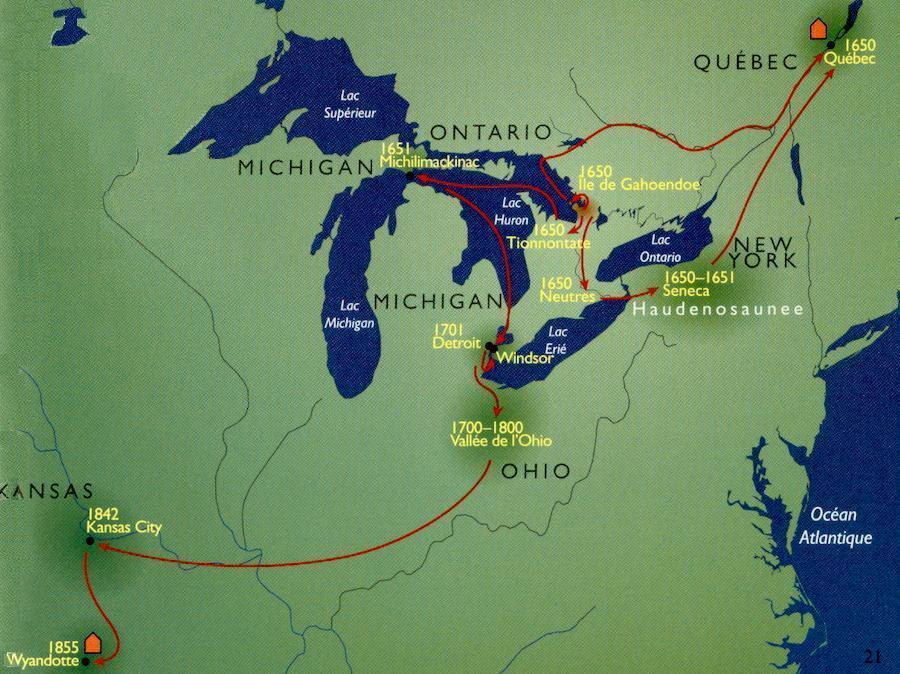
Images are available under the Creative Commons ShareAlike License
About Jars
The jar is a basic utilitarian shape, a container generally for cooking food, storing grain or for carrying and storing water. The jar's outer surface is a canvas where potters have been expressing their religious visions and stories for centuries.
In Sinagua pueblos (in northern Arizona), the people made very large jars and buried them up to their openings in the floors of the hidden-most rooms in their pueblo. They kept those jars filled with water but also kept smaller jars of meat and other perishables inside those jars in the water. It's a form of refrigeration still in use among indigenous people around the world.
Where bowls tend to be low, wide and with large openings, jars tend to be more globular: taller, less wide and with smaller openings.
For a potter looking at decorating her piece, bowls are often decorated inside and out while most jars are decorated only on the outside. Jars have a natural continuity to their design surface where bowls have a natural break at the rim, effectively yielding two design surfaces on which separate or complimentary stories can be told.
Before the mid-1800s, storage jars tended to be quite large. Cooking jars and water jars varied in size depending on how many people they were designed to serve. Then came American traders with enameled metal cookware, ceramic dishes and metal eating utensils...Some pueblos embraced those traders immediately while others took several generations to let them and their innovations in. Either way, opening those doors led to the virtual collapse of utilitarian pottery-making in most pueblos by the early 1900s.
In the 1920s there was a marked shift away from the machinations of individual traders and more toward marketing Native American pottery as an artform. Maria Martinez was becoming known through her exhibitions at various major industrial fairs around the country and Nampeyo of Hano was demonstrating her art for the Fred Harvey Company at the Grand Canyon. The first few years of the Santa Fe Indian Market helped to solidify that movement and propel it forward. It took another couple generations of artists to open other venues for their art across the country and turn Native American art into the phenomenon it has become.
Today's jars are artwork, not at all for utilitarian purposes, and their shapes, sizes and decorations have evolved to reflect that shift.
